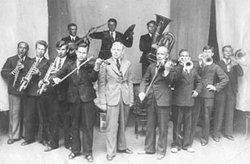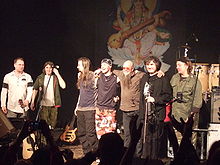- Soviet music
-
Soviet music is the music composed and produced in the USSR. It varied in many genres and epochs. Although the majority of it was written by Russians, it was also influenced by various national minorities in the Soviet Republic. The Soviet state supported musical institutions, but also carried out content censorship. Music was closely monitored, but had more freedom than religion and speech.
According to Lenin:
"Every artist, everyone who considers himself an artist, has the right to create freely according to his ideal, independently of everything. However, we are Communists and we must not stand with folded hands and let chaos develop as it pleases. We must systemically guide this process and form its result."[1]
Contents
Classical music of the USSR
Classical music of the Soviet Union developed from the music of the Russian Empire. It gradually evolved from the eccentric experiments of the revolutionary era, such as orchestras with no conductors, towards classicism favored under Joseph Stalin's office. the Union of Soviet Composers was established in 1932, and became the major regulatory body in Russia's music. Later in the 1930s, Joseph Stalin enacted more boundaries for music, which was then further limited in content and innovation. Classicism was favoured, and experimentation was discouraged.[2] For example, Shostakovich's veristic opera Lady Macbeth of the Mtsensk District was denounced in Pravda newspaper as "formalism" and soon removed from theatres for years.
The music patriarchs of the era were Prokofiev, Shostakovich and Aram Khachaturian, whose careers started before the Revolution. With time, a wave of younger Soviet composers, including Georgy Sviridov, Tikhon Khrennikov, Alfred Schnittke managed to break through, partially thanks to the Soviet education system.[3]
Many musicians from the Soviet era have established themselves as world's leading artists: violinists David Oistrakh, Leonid Kogan, Gidon Kremer, Viktor Tretyakov and Oleg Kagan; cellists Mstislav Rostropovich, Daniel Schafran, and Natalia Gutman; violist Yuri Bashmet; pianists Sviatoslav Richter, Emil Gilels and many other musicians.
1930-1950s Soviet jazz
Jazz music was introduced to Soviet audiences by Valentin Parnakh in 1920s. Singer Leonid Uteosov and film score composer Isaak Dunayevsky helped its popularity, especially with the popular comedy film Jolly Fellows that featured a jazz soundtrack. Eddie Rosner, Oleg Lundstrem and others contributed to Soviet jazz music.
In late 1940s, during the "anti-cosmopolitanism" campaigns, jazz music suffered from ideological oppression, as it was labeled "bourgeois" music. Many bands were dissolved, and those that remained avoided being labeled as jazz bands.
In the 1950s underground samizdat jazz journals and records became more common to disseminate musical literature and music.[4]
Film soundtracks
Film soundtracks produced a significant part of popular Soviet/Russian songs of the time, as well as orchestral and experimental music. During the 1930s, Sergei Prokofiev's composed scores for Sergei Eizenshtein films, such as Alexander Nevsky, and also soundtracks by Isaak Dunayevsky that ranged from classical pieces to popular jazz. Among the pioneers of Soviet electronica was 1970s ambient composer Eduard Artemiev, best known for his scores to science fiction films by Tarkovsky. Because of propaganda and censorship, even the film music had to be nationalistic in nature, incorporating aspects of folk music and other Russian musical influences.
Further information
1960-70s: the VIAs
 A typical 70s Soviet VIA, Tsvety, in the hippie-inspired dress of the era
A typical 70s Soviet VIA, Tsvety, in the hippie-inspired dress of the era Main article: VIA music
Main article: VIA musicThe 1960s saw the rise of the VIA (Vocalno-instrumentalny ansambl, vocal&instrumental ensemble) movement. VIAs were state-produced bands of professional musicians, often performing songs written for them by professional composers from the Composers' Union of the USSR, such as Alexandra Pakhmutova, Yan Frenkel and Raimonds Pauls. Among the most notable acts were Pesneri, a folk band from Belarus; Zemliane, Poyushie Gitari, Yuri Antonov with Arax, Stas Namin with Tsvety.
To break through into the mainstream with state-owned Soviet media, any band should have become an officially recognized VIA. Each VIA had an artistic director (художественный руководитель) - whom acted as manager, producer and state supervisor. In some bands, namely Pesniary, the artistic director was also the band's leading member and songwriter.
Soviet VIAs developed a specific style of pop music. They performed youth-oriented, yet officially approved radio-friendly music. A mix of western and Soviet trends of the time, VIA combined traditional songs with elements of Rock, Disco and New wave music. Folk music instruments were often used, as well as keytars. Many VIAs had up to ten members including a number of vocalists and multiinstrumentalists, whom were in constant rotation.
Due to state censorship, the lyrics of VIAs used to be "family-friendly". Typical lyrical topics were emotions such as love, joy and sadness. Many bands also praised national culture and patriotism, especially those of national minorities from smaller Soviet republics.
1960-70s: Bard music
 Bulat Okudzhava, a bard
Bulat Okudzhava, a bard Main article: Bard (Soviet Union)
Main article: Bard (Soviet Union)The Singer–songwriter movement of the Soviet Union is deeply rooted in amateur folklore songs played by students, tourists and travelling geologists. It became highly popular in 1960s and was sometimes considered as an alternative to official VIAs. Music characteristics of the genre consist of simple, easily-repeatable parties, usually played by a single acoustic guitar player who simultaneously sang. Among the singer-songwriters, termed as "bards", the most popular were Bulat Okudzhava, Vladimir Vysotsky, Yuri Vizbor, Sergey and Tatyana Nikitins. Lyrics played the most important role in Bard music, and bards used to be more like poets than musicians.
1980s: Russian rock
Aquarium were one of the pioneering Russian rock bands Main article: Russian rock
Main article: Russian rockRock music came to Soviet Union in the late 1960s with Beatlemania, and many rock bands arose during late 1970s: Mashina Vremeni, Aquarium, Autograph. Unlike VIAs, these bands were not allowed to publish their music and remained underground. The "golden age" of Russian rock is widely considered to have been during the 1980s. Censorship mitigated, rock clubs opened in Leningrad and Moscow, and soon rock became mainstream[5] Popular bands of this time period include Kino, Alisa, Aria, DDT, Nautilus Pompilius and Grazhdanskaya Oborona. New wave and post punk were also trends in '80s Russian rock.
See also
References
- ^ Lenin, O Kulture i Iskusstve (about Culture and Art), Moscow, 1957, pp 519-520
- ^ Soviet Music and Society under Lenin and Stalin: The Baton and Sickle. Edited by Neil Edmunds. Routledge, 2009. Pages: 264. ISBN 978-0-415-54620-1
- ^ Amy Nelson. Music for the Revolution. Musicians and Power in Early Soviet Russia. Penn State University Press, 2004. 346 pages. ISBN 978-0-271-02369-4
- ^ Culshaw, Peter (2006-10-14). "How jazz survived the Soviets". The Telegraph. http://www.telegraph.co.uk/culture/music/rockandjazzmusic/3656544/How-jazz-survived-the-Soviets.html. Retrieved 2011-07-01.
- ^ Walter Gerald Moss. A History Of Russia: Since 1855, Volume 2. Anthem Series on Russian, East European and Eurasian Studies. Anthem Press, 2004. 643 pages.
External links
- SovMusic.ru, Probably the biggest Soviet music archive at the Internet
Categories:
Wikimedia Foundation. 2010.


